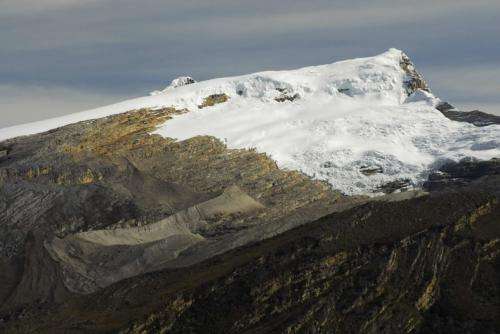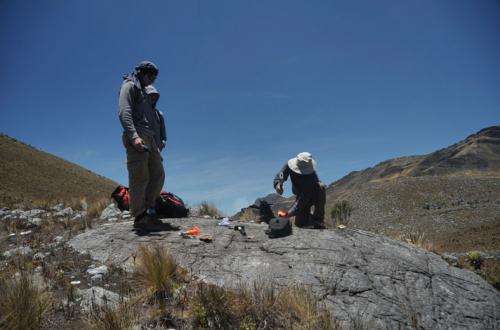Cold snap in the tropics

Tropical glaciers have responded to episodes of cooling in Greenland and the Antarctic over the past 20,000 years, according to a study carried out mainly by researchers at the CNRS, Université Joseph Fourier, Aix-Marseille Université and the IRD, in collaboration with other French scientists and colleagues in the US, Colombia and the UK. Their work, which covers 21 Andean glaciers, is published on August 24th, 2014 in the journal Nature.
As elsewhere on the planet, tropical glaciers (located on either side of the equator between 23°N and 23°S) have been retreating since the Last Glacial Maximum around 20,000 years ago. This retreat has been interrupted by stillstands and re-advances, although a detailed chronology of these events in tropical regions remained unclear until now. Analyses carried out by an international group of researchers in the Andes (where more than 99% of tropical glaciers are found) show that these glaciers expanded not only during cooling over Greenland (12,000 years ago) but even more so during a cold event in Antarctica (14,000 years ago).
The researchers focused on these periods since the northern and southern hemispheres showed contrasting climate trends at that time. From 14,500 to 12 900 years ago, warming in the Antarctic was interrupted (this was the Antarctic Cold Reversal, or ACR), while temperatures in Greenland were relatively warm. In contrast, the following period, known as the Younger Dryas (YD, 12,900 to 11,600 years ago), was marked by cooling in the northern hemisphere, while temperatures in the Antarctic started to rise again. As tropical glaciers are located half way between the two regions, they could have been expected to respond indiscriminately to both cooling periods. However, until now, it was thought that the glaciers were only affected by events in the northern hemisphere, based on the dating of past glacial advances. Ascertaining the quality of this dating was therefore key to analyzing past response to climate conditions in the Andes.
Dating the phases of glacial advance requires to analyze moraines, rocky debris carried along by the glacier. When the glacier starts to retreat, the frontal moraines are no longer protected by the ice, and a sort of 'geological chronometer' is triggered, as the rocks begin to accumulate beryllium-10 and helium-3 produced by particles resulting from cosmic rays.

Around twenty glaciers in Venezuela, Peru, Bolivia and northern Argentina had already been dated in this way. However, the large uncertainties and differences in the methods used, prevented any accurate comparison. After first improving the accuracy and reliability of their geochronometers, the team of researchers updated the chronology using a standardized method, adding the dating of moraines in the Ritacuba Negro glacier in Colombia (northern tropical Andes).
The scientists were thus able to demonstrate that, on a thousand-year scale, tropical glaciers both north and south of the equator evolved in a similar manner. The overall retreat of several kilometers that has occurred over the past 20,000 years was interrupted by a stillstand or a re-advance of several hundred years at the beginning of the ACR, and then by increasingly minor glacial episodes at the end of the YD, at the beginning of the Holocene (around 10,000 years ago) and during the Little Ice Age (13th to 19th centuries).
A climate model was then used to elucidate the origin of these fluctuations.. It shows that changes in temperature, rather than in precipitation, were the cause of the main glacier fluctuations during the ACR and YD. These local temperature variations are themselves attributed to the global increase in CO2 concentrations, together with changes in the strength of ocean currents, which redistribute heat and smooth out temperature differences between the poles and the tropics.
The research shows that tropical glaciers have their own dynamics (different from that of the more extensively studied Alpine glaciers), which incorporates climatic influences from both hemispheres (rather than mainly from the northern hemisphere, which is the case for Alpine glaciers). A key point is that tropical glaciers are of crucial importance to Andean populations, who depend on them for drinking water and electricity. Yet tropical Andean glaciers have already lost 30 to 50% of their surface area in the last forty years, and it is therefore essential to elucidate how they respond to climate variations. What has been learnt from these glaciers will enable scientists to improve their understanding of the regional impacts of global climate change under the influence of rising atmospheric CO2 concentrations and the redistribution of energy by the oceans.
More information: "A major advance of tropical Andean glaciers during the Antarctic Cold Reversal," V. Jomelli, V. Favier, M. Vuille, R. Braucher, L. Martin, P-H. Blard, C. Colose, D. Brunstein, F. He, M. Khodri, D. Bourlès, L. Leanni, V. Rinterknecht, D. Grancher, B. Francou, J.L. Ceballos, H. Fonseca, Z. Liu, B. Otto-Bliesner, Nature, August 24th, 2014. DOI: 10.1038/nature13546
Journal information: Nature
Provided by CNRS


















